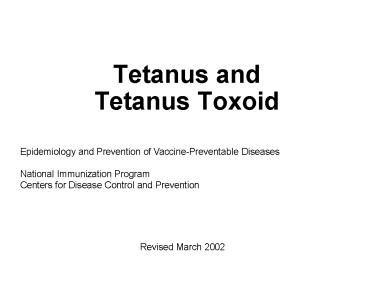Tetanus and Tetanus Toxoid - PowerPoint PPT Presentation
Title:
Tetanus and Tetanus Toxoid
Description:
Tetanus and Tetanus Toxoid Epidemiology and Prevention of Vaccine-Preventable Diseases National Immunization Program Centers for Disease Control and Prevention – PowerPoint PPT presentation
Number of Views:69
Avg rating:3.0/5.0
Title: Tetanus and Tetanus Toxoid
1
- Tetanus and Tetanus Toxoid
Epidemiology and Prevention of Vaccine-Preventable
Diseases National Immunization Program Centers
for Disease Control and Prevention
Revised March 2002
2
Tetanus
- First described by Hippocrates
- Etiology discovered in 1884 by Carleand Rattone
- Passive immunity used for treatment and
prophylaxis during World War I - Tetanus toxoid first widely used during World War
II
3
Clostridium tetani
- Anaerobic gram-positive, spore-forming bacteria
- Spores found in soil, dust, animal feces may
persist for months to years - Multiple toxins produced with growth of bacteria
- Tetanospasmin estimated human lethal dose 150
ng
4
Tetanus Pathogenesis
- Anaerobic conditions allow germination of spores
and production of toxins. - Toxin binds in central nervous system
- Interferes with neurotransmitter release to block
inhibitor impulses. - Leads to unopposed muscle contraction and spasm.
5
Tetanus Clinical Features
- Incubation period 8 days (range, 3-21 days)
- Three clinical forms Local (uncommon), cephalic
(rare), generalized (most common) - Generalized tetanus descending symptoms of
trismus (lockjaw), difficulty swallowing, muscle
rigidity, spasms - Spasms continue for 3-4 weeks complete recovery
may take months
6
Neonatal Tetanus
- Generalized tetanus in newborn infant
- Infant born without protective passive immunity
- High fatality rate without therapy
- Estimated 270,000 deaths worldwide in 1998
7
Tetanus Complications
- Laryngospasm
- Fractures
- Hypertension
- Nosocomial infections
- Pulmonary embolism
- Aspiration
- Death
8
- Tetanus Wound Management
Yes, if gt10 years since last dose
Yes, if gt5 years since last dose
9
Tetanus Epidemiology
- Reservoir Soil and intestine of animals
and humans - Transmission Contaminated wounds Tissue
injury - Temporal pattern Peak in summer or
- wet season
- Communicability Not contagious
10
- Tetanus - United States, 1947-2001
2001 provisional data
11
- Tetanus - United States, 1980-2001
2001 provisional data
12
- Tetanus United States, 1980-2000
- Age Distribution
13
- Age Distribution of Reported Tetanus Cases,
1991-1995 and 1996-2000
14
- Tetanus - 1995-1997
- Injuries and Conditions
Data available for 120 of 124 reported cases
15
DTaP, DT, and Td
Pertussis vaccine and pediatric DT used through
age 6 years. Adult Td used for persons 7 years
and older.
16
Tetanus Toxoid
- Formalin-inactivated tetanus toxin
- Schedule Three or four doses booster Booster
every 10 years - Efficacy Approximately 100
- Duration Approximately 10 years
- Should be administered with diphtheria toxoid as
DTaP, DT, or Td
17
- Routine DTaP Primary Vaccination Schedule
18
Children Who Receive DT
- The number of doses of DT needed to complete the
series depends on the childs age at the first
dose - if first dose given at lt12 months of age, 4 doses
are recommended - if first dose given at gt12 months, 3 doses
complete the primary series
19
Routine DTaP ScheduleChildren lt7 years of age
Booster Doses
- 4-6 years, before entering school
- 11-12 years of age if 5 years since last dose
(Td) - Every 10 years thereafter (Td)
20
- Routine Td Schedule
- Persons gt7 years of age
Booster dose every 10 years
21
Diphtheria and Tetanus ToxoidsAdverse Reactions
- Local reactions (erythema, induration)
- Exaggerated local reactions reactions
(Arthus-type) - Fever and systemic symptoms uncommon
- Severe systemic reactions rare
22
Diphtheria and Tetanus ToxoidsContraindications
and Precautions
- Severe allergic reaction to vaccine component or
following prior dose - Moderate to severe acute illness
23
National Immunization Program
- Hotline 800.232.2522
- Email nipinfo_at_cdc.gov
- Website www.cdc.gov/nip































